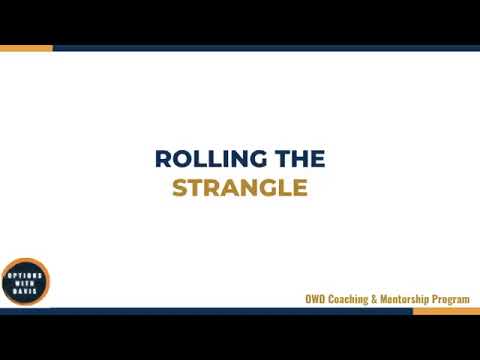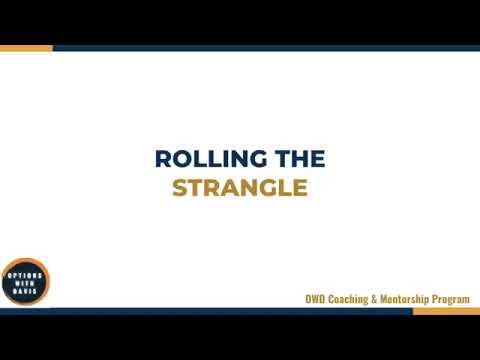In the video “3-15 Rolling the Strangle” by Find a Service NOW, you’ll learn about the process of rolling a strangle options strategy. Rolling a strangle is simpler than rolling an iron condor because it only involves two legs instead of four. The video explains that rolling should only be done when your strikes get tested and there is still more than 24 days to expiration (DTE) left. You also want to make sure you can get a net credit after commissions. The video offers guidelines for rolling the neutral strangle, bullish triangle, and bearish triangle. Remember, the key is to take action when there is still time in the trade and when the strikes have been breached.
Rolling the Strangle

Introduction
Rolling the strangle strategy is much easier compared to rolling the iron condor strategy. This is because a strangle only has two legs, while an iron condor has four legs. In this article, we will discuss the guidelines for rolling the strangle, as well as specific techniques for rolling the neutral strangles, bullish triangles, and bearish triangles.
Rolling Guidelines
Before we delve into the specific rolling techniques, let’s establish some general guidelines for when to roll a strangle. Firstly, it is important to only consider rolling if your strikes have been tested. If the strikes remain untested, meaning the market is well within the profit zone, it is best to leave the trade untouched and let the strategy work. Additionally, it is crucial to ensure that there is still more than 24 days to expiration (DTE) remaining in the trade. This is because we want to have at least 3 days left until the 21 DTE mark, which is the point where we want to exit the trade. If there are less than 3 days until the 21 DTE mark, there is no real point in rolling the trade. Lastly, rolling should only be considered if you can achieve a net credit after accounting for commissions. It is generally recommended to roll down or up rather than rolling out in time. While rolling out in time may give the trade more time to work, it also lowers the probability of the trade and may result in a bigger loss. It is important to note that our trading method already has an edge without rolling out, so there is no real need to roll out. However, if you have personal experience with successful rolling out strategies, feel free to implement them.
Rolling the Neutral Strangles
If the market is within the short strikes of a neutral strangle, there is no need to take any action. The trade is still within the profit zone, so it is best to let it continue. However, if the strikes are being tested, the first step is to determine the remaining time in the trade. If there is less than 24 DTE, it is best to do nothing. On the other hand, if there is more than 24 DTE, it is advisable to roll the untested side to reestablish the initial delta or even go higher. For example, if the price touches the call strike, the call strike will have a delta of around 50. However, the put side will have a delta much lower than the initial 16 delta. This presents an opportunity to roll the put side up to obtain credit. You can choose to roll up to the initial 16 delta or even higher, such as 25 delta. If the market continues to move further and the short strike goes deeper in the money, you can further roll up the put strike.
Rolling the Bullish Triangles
Similar to the neutral strangles, if the strikes in a bullish triangle are not being tested or there is little time remaining in the trade, it is best to take no action. However, if there is more than 24 DTE, rolling the call side down is recommended. By rolling down, you can reestablish the initial delta or opt for a higher delta. Rolling to the 20 or 25 delta is possible, depending on your preference. Rolling down the call side can also help reduce the loss on the put side, as you will receive credit each time you roll it down. If the market breaches the call side, and there is no time remaining in the trade, it is best to do nothing. However, if there is still time, you can choose to roll the put strike up. Additionally, if the market continues to rise, you can keep rolling the put up as needed.
Rolling the Bearish Triangles
In the case of bearish triangles, where the call side has a higher delta and the market is closer to the call strike, rolling up the put side is the recommended strategy. If there is no time remaining in the trade, there is no need to take any action. However, if there is still time, rolling the put up to reestablish the initial delta or even a higher delta is advised. If the market moves towards the put side, which is now further away, and there is no time remaining in the trade, it is best not to take any action. However, there is a chance of the market retracing, so you can choose to do nothing and observe. Alternatively, you can roll the call down to a higher delta, depending on the credit you can obtain. If the market continues to move down, you can consider rolling the call down as well.
By following these rolling guidelines and techniques, you can effectively manage your strangle trades and make adjustments as needed. Remember to only roll if your strikes have been tested and there is still ample time remaining in the trade.
